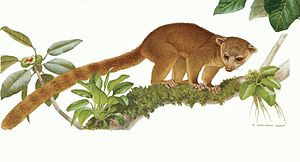Makibear
| Makibear | ||||||||||||
|---|---|---|---|---|---|---|---|---|---|---|---|---|

Makibear ( Bassaricyon alleni ), illustration |
||||||||||||
| Systematics | ||||||||||||
|
||||||||||||
| Scientific name | ||||||||||||
| Bassaricyon alleni | ||||||||||||
| ( Thomas , 1880) |
The Makibär ( Bassaricyon alleni ) or actually Makibär, is a kind of Makibär that belongs to the small bears .
features
The Makibear is a medium-sized species of Makibear, smaller than the Central American Makibear ( Bassaricyon gabbii ) but larger than the Andean Makibear ( Bassaricyon neblina ). The body is slender with relatively short front legs and slightly longer rear legs. It reaches a body length of about 70.5 to 98.5 centimeters, with about 40 to 53 centimeters being attributable to the tail. The tail length is 1.0 to 1.4 times the length of the head body. The body weight is 1.1 to 1.5 kg. The feet are wide with curved claws, the hind feet are about 7.2 to 9.2 inches long. The ears are rounded, the ear length is 3 to 4.3 centimeters. Specimens from the eastern slope of the Andes from heights above 1000 meters have longer fur, shorter tails and are more brownish and less orange-brown in color than the animals from the Amazonian lowlands.
The species is very similar to its sister species, the Chocó-Makibär ( Bassaricyon medius ), but has more dark hair tips in the dorsal fur, which means that the fur of the Maki bear is slightly darker than that of the Chocó-Maki bear. The skull is a little wider and the muzzle a little shorter. The tympanic membrane is more distended and the fourth premolar is larger. The nose of the maci bear is often pink, while that of the chocó maci bear is dark. The Makibär is significantly larger than Bassaricyon medius medius , the Colombian subspecies of the Chocó-Makibär and has about the same body dimensions as B. m. orinomus , the Panamanian subspecies of the Chocó Maki bear. The coloring of the macibear is relatively uniform, whereas B. m. orinomus often has a reddish tail. The genetic distance between the maci bears and the Chocó maci bears, determined by a DNA analysis of the genes of the protein cytochrome b , is 6 to 7%.
distribution and habitat
The actual Makibear is the only species of Makibear east of the Andes. The very large distribution area is in the rainforests of the Amazon basin and extends from northwestern Bolivia and eastern Peru and Ecuador to western Brazil (states Amazonas and Acre , probably also in Roraima and Pará ). In Guyana the species is proven by two specimens (the type specimens of Bassaricyon beddardi ) Evidence from Surinam and French Guiana is missing.
In its area of distribution, the Makibear lives from the Amazonian lowlands up to heights of 2000 meters. Most of the animals live below 1000 meters, but on the eastern slopes of the Andes, where the Andean Makibear is missing, the animals can be found at heights of 2000 meters.
Way of life and ecology
Although the Makibear is the best studied species of the genus, little is known about its way of life. It lives in moist forests and is nocturnal, solitary and arboreal, but also goes to the ground to get from tree to tree when the crowns do not touch. The food consists mainly of fruits, insects, small rodents and lizards, nesting birds and eggs are also eaten. When threatened, the animals release a foul smelling odor. Males are aggressive towards one another. The females get a single young animal after a gestation period of 72 to 74 days.
Systematics
The actual Makibär is a type of Makibär (genus Bessaricyon ), which is currently divided into four types. No subspecies of the Makibear are currently distinguished. The population in Guyana has been described as a separate species, Beddards Makibär ( Bassaricyon beddardi ). The holotype , a specimen originally kept in a zoo, has since been lost and the independence of the species has never been confirmed. Morphologically and in terms of molecular genetics, there are hardly any differences between the specimens from Guyana and macibears from the Peruvian Amazon. Bassaricyon beddardi was therefore synonymous with Bassaricyon alleni .
Hazard and protection
The species is rated by the International Union for Conservation of Nature and Natural Resources (IUCN) as "Least Concern" due to its relatively large distribution area and occurrence in numerous protected areas. Habitat loss through deforestation is seen as the main threat to individual populations.
Individual evidence
- ↑ a b c d Kristofer M. Helgen , Miguel Pinto, Roland Kays, Lauren Helgen, Mirian Tsuchiya, Aleta Quinn, Don Wilson, Jesus Maldonado: Taxonomic revision of the olingos (Bassaricyon), with description of a new species, the Olinguito. ZooKeys 324 (2013): Special issue: 1-83. doi : 10.3897 / zookeys.324.5827
- ↑ Bassaricyon alleni in the endangered Red List species the IUCN 2015 Posted by: slipway, K., Kays, R. Pinto, C. & Schipper, J., 2016. Accessed April 16, 2018th
